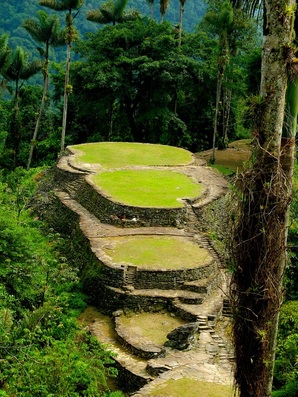 La Cuidad Perdida
La Cuidad Perdida Santa Marta & DumPster Kitty
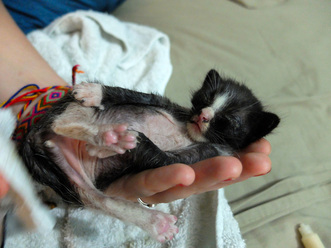 TINY guy
TINY guy  La Cuidad Perdida La Cuidad Perdida After our time in San Gil we were ready to head north to the Caribbean and spend some time lounging on a beach, but not before earning it. We arrived in Santa Marta early in the morning and settled into a hostel near the main market area. At first glance the city was pretty terrible: smelled of urine and rotting garbage mixed with thick black car exhaust, noisy vehicles, sketchy people, etc. I had no interest in walking around so after inquiring into “La Ciudad Perdida” (the Lost City) five-day trek through the jungle, I decided to relax and read a book for the rest of the day. Santa Marta & DumPster Kitty TINY guy TINY guy Andrew went to the bank machine and for a little walk around our area. I had expected him to take longer but after 10 or 15 minutes he barged into the room panicking, with something tucked away in his shirt. At first I thought it was a mouse or a small rat, Andrew just mumbled that he had found it screaming on a sidewalk and could barely explain that no one seemed to care and someone made fun of him for picking it up! It was a TINY kitten. Couldn’t have been more than 4 or 5 days old, with eyes still closed and one of them swollen to half the size of its head. Its hair was thick with dirt and smelled like human urine! Our hearts broke and we didn’t know what to do. Feeling like this kitten urgently needed some food, we left the hostel in search of a veterinarian. It took us far too long to find one but we eventually did after wandering through nasty smelly sweaty streets and market stands. We bought a container of kitten milk powder that you just add water to and a syringe we could use to try and feed him. We hurried back to the hostel and sterilized the syringe. Using a damp towel I cleaned the kitten as best I could while Andrew mixed some milk. It took some time to convince the kitten to eat from the syringe, but with patience we got the job done.
4 Comments
After defeating Greece 3-0 and a closer win over the Ivory Coast at 2-1, Colombia gears up today to play Japan. In Colombia, “gearing up” means…
Loving Colombia so far! We arrived in Bogotá after a 16 hour journey, flying from Buenos Aires through Lima (and staying overnight in the airport). We landed fairly early in the day and were settled into Hostel Sue Candeleria in the La Candelaria district (the more touristy and unfortunately more sketchy area). It was federal election day and the day after Colombia's first World Cup win (and subsequent celebratory rioting) so Bogotá was a bit rowdy. We asked a couple of military guys at the airport if it was safe to hang out in Bogotá during the election and how things were going, and they just said “todo tranquilo, hay muchas policías en las calles, esta muy seguro” (everything is good, there are many police in the streets, it is very safe) – that sounded pretty good so we decided to go for a little walk around. 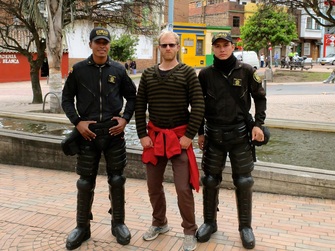 Bogotá police in their skateboarding gear Bogotá police in their skateboarding gear We intended to try and get to Plaza Bolívar (the main square) but never made it that far because the police had put up barricades, likely to stop people from gathering in crowds. We just wandered around La Museo de Oro (the Gold Museum) listening to the street music, watching the vendors selling all kinds of delicious fried or sugar-coated snacks and, of course, giving trying some of them a try. I had a version of the delicious Alfajor from Argentina (Argentina's version is a bazillion times better) – this one was just some plain crispy wafers with a bunch of dulce de leche (thick caramel sauce) in between, mmmmm. I had eaten most of it but had maybe three or four bites left when a happy looking (possibly homeless) guy asked me for some money. Instead, I gave him the rest and he happily thanked me and wandered away, dancing and singing. Things seemed OK in the streets; there were several police and military people just hanging around and patrolling everywhere, with their massive guns at their sides. While some people may find that comforting, I found it unnerving.
 an ayahuasca-inspired wall-hanging? an ayahuasca-inspired wall-hanging? A number of times over our past months in South America, we've come across references to an herbal drink called "ayahuasca". In a traditional ceremony led by an indigenous shaman, participants take ayahuasca and are then whisked away on an epic journey of self-discovery and flowery hallucinations. After numerous recommendations from people we've met along the way, we finally decided to see what all the fuss is about. The following recounts in detail what turned out to be an incredibly intense and emotional adventure that took place during a three day "spiritual retreat" near Cuzco, Peru. In deciphering my wildly scrawled notes from the retreat while recounting the experience, I’ve realized how bizarre the whole experience must sound to someone who hasn't been through it. All I ask is for readers to keep an open mind… at least until reaching the end, after which they’re free to call me all sorts of critical and creative names. Enjoy! ~ Mandrew Background ayahuasca being prepared over the fire ayahuasca being prepared over the fire Ayahuasca (“death’s rope” in the Quechua language) is a species of vine found in the Amazon Jungle and has a rich history of use by shamans as a means of communicating with the spirit world. In Ecuador and Peru especially, wild legends and stories about shamans are commonplace. It’s said that ayahuasca opens a doorway into an alternate dimension, allowing skilled shamans to acquire objects of power or receive guidance from extra-dimensional beings. I’ve heard tell that powerful shamans can physically transform themselves into jungle animals or even remotely poison or kill people through the spirit dimension. Such ideas have been around for thousands of years and are often found depicted on ceramics, textiles, and rock art uncovered from these ancient cultures.
Just like in many other indigenous groups throughout the world, shamans (a.k.a. medicine men, druids, or witchdoctors) are men of power, highly revered in society and often relied upon for their spiritual knowledge and healing abilities. Throughout the Amazon Basin, a skilled shaman is one who, with the help of ayahuasca, can successfully interpret and control the spirit world, and in doing so identify and remove the negative spirits that are the root cause of one's ails (and hopefully prevent other evils from entering while the portal is open). In modern day, ayahuasca remains widespread in Ecuador, Peru, Colombia, and Brazil, not only as a rite of passage amongst indigenous cultures (our Shaman's first experience was at the tender age of seven), but also as a treatment for mental or emotional conditions, a means of better understanding one's self, and, of course, a hippy-dippy trip for curious backpackers. Some families gather every year for an ayahuasca ceremony as a means of maintaining a healthy, mind, body, and spirit. There's even a religion in Brazil in which members drink ayahuasca tea at weekly gatherings. Many people who have taken ayahuasca claim that it opens up a connection with the energy of the universe, allowing them to overcome difficult crises or discover their true purpose in life. I agree - it all sounds pretty nuts! 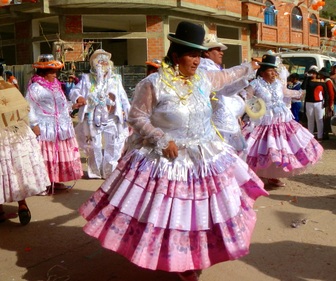 Some of the crazy dancers in Copacabana Some of the crazy dancers in Copacabana Hola de Bolivia! (Hello from Bolivia). After our Gringo Trail adventure through Peru we headed across the border at Lake Titicaca to Bolivia. This was one of the easiest crossings we have done: we took a collectivo (shared van/taxi) from Puno to the border, walked across stopping in a shack part way through to get our stamps, and hopped into a tuk-tuk (motorized rickshaw) to Copacabana.
When we arrived there was a crazy Carnival celebration going on so we had to stop before the crowded centre and walk with our backpacks, pushing through crowds to a super shitty hostel (not much choice because of the celebration). After settling in a bit we went back out to the streets to see what was goin' on. There were parades of people dancing and singing, dressed in all kinds of crazy costumes, some with masks. Almost everyone had a beer in their hand, even the dancers and musicians. The sides of the streets were lined with food and drink stands and there were huge speakers blaring what sounded like the same song over and over again for hours very late into the night.  Something about this photo gives me the heebie-jeebies Something about this photo gives me the heebie-jeebies Shamans, medicinal plants, earthquakes, ancient cities, mysterious symbols; Peru really is the most diverse and magical country we have been to so far! Since this is our first visit to Peru (though likely not our last) we decided to go a bit more mainstream than usual and visit the recommended sites along the well-known "Gringo Trail", taking us through all of the major attractions of the country, starting with Lima. To start out on our route we headed via airplane from Iquitos to Lima, in order to save a week or more of time (the other option was another multi-day cargo boat from Iquitos since it has no road access, followed by a 24+ hour bus ride). We didn't spend much time in Lima before departing to Pisco to visit the Ballestas Islands and Paracas National Reserve, and to unexpectedly experience a 5.7 magnitude earthquake while face-timing with Donna and Jim, Andrew's parents. The next stop on the Gringo Trail was Nazca where we saw for ourselves the infamous Nazca Lines and learned a lot about the ancient cultures that inhabited the area between 100bc and 800ad, and then spent the next few days barfing due to the horrific flight over the lines and/or some bad food or water, who knows what. After Nazca was Arequipa, the second most populous city in Peru and the hub to get to the beautiful Colca Canyon (but we decided not to go there since it was a bit far and really expensive). Finally, we arrived in Cusco, our base for some intense Shamanism and of course, to visit Machu Picchu. Next and last on the list (heading out this afternoon via bus) will be the town of Puno where we can visit Lake Titicaca before crossing the border into Bolivia. We can really see why so many people travel this route: the diverse beauty and culture have taken our breath away almost every day since we have arrived. Gringo Trail - click on the icons for informationIquitos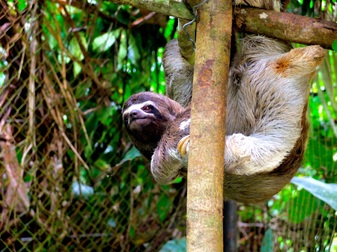 Chili sloth Chili sloth Following our insane Rio Napo trip we spent a couple of days exploring the incredibly loud Amazonian city of Iquitos. There were hardly any cars or trucks in the city, but thousands of moto-taxis (converted motorbikes with carriages on the back), thus the very noisy streets. We have come to realize, however, that almost everywhere in South and Central America so far the people seem to need noise at all hours of the day. You can't help but wonder if they purposfully design the bikes to be extra loud!
On one day while our muuuuuuch needed laundry was being done we wandered around the Belen Market, where one may find almost any kind of medicinal plant (or animal for that matter) you can think of. Of course, as is always wise while wandering in local markets, we only took out our camera a few times and made sure that not many people saw us with it, and we left anything else of any value back at the hostel. 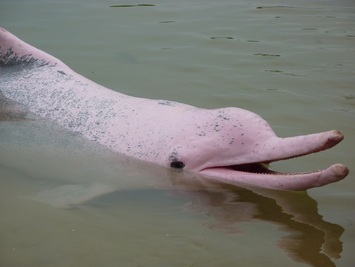 photo courtesy of electrictreehouse.com photo courtesy of electrictreehouse.com Yes they are real, and we have seen them! There is a story for the more manly in here too, don't worry. It involves criminals and crocodiles... ! During our trip along the Rio Napo from Coca to Iquitos our first stop was in a tiny town called Nuevo Rocafuerte, the place to find a local guide to take you on a trip into Yasuni National Park (without having to pay the crazy prices quoted by travel agencies in Coca). Yasuni National Park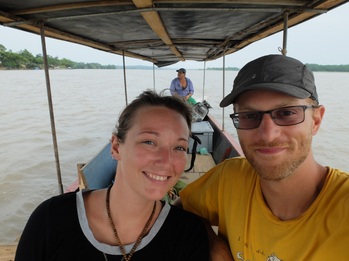 Starting our trip with Roni at the helm Starting our trip with Roni at the helm We met Roni Cox while walking around Nuevo Rocafuerte (NR) after only ten minutes. He pulled his motorcycle over to us and asked (in Spanish, of course) if we wanted a guide (himself) to Yasuni National Park. While that is exactly what we were looking for and he seemed super cool, we weren’t too quick to accept. We had been reading a few too many horror stories about people going into the jungle with fake “guides” who essentially take people down the river to their friend’s place and rob and/or murder them. I don’t think any of these stories came directly from NR, but after the weirdo motorbike robber encounter in Coca, we've been a bit more on our toes. We told him that we were actually looking for Frederico (a guide that a Park Ranger recommended to us) but we would consider his offer and come by his house later that day to let him know. We knew that there was a College in town (down the only street) that trains guides so we went there and asked if they knew Roni. They sure did and said that he was great.  admiring the sunset from our lancha admiring the sunset from our lancha Within a few hours we managed to meet a couple of solo travellers, María-José from Chile and Rodrigo from Argentina, who were also looking to go into the park and after some consideration the four of us decided to go for it! Roni turned out to be a great guide, very enthusiastic and funny. The four of us had a blast riding in the smaller lancha (boat with outboard motor) through the Yasuni River and into a large lagoon called Jatuncocha (Quecha for "large lake"). We spent 3 days and 2 nights in the park, hiking for a few hours each day, learning about the plants and birds, watching the pink river dolphins breaching in the river (SO COOL!!), and fishing for piranhas before dark. After eating dinner and playing a couple rounds of cards (ninety-nine, or noventa y nueve en Español), we took the lancha out to do some caiman watching! We really didn’t have too much chill time, always on the go and keeping watch for some rare creatures! Mandrew had a great time snapping photos of birds as we passed by - he said it was a lot like the video game "Pokemon Snap" or something ... On the last day we did end up seeing the giant river otters, which was a great bonus! 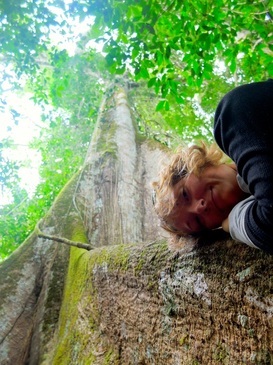 Chelsea listening to the tree spirits... Chelsea listening to the tree spirits... When we got back to NR we parted ways with María-José and Rodrigo, sadly as they were a lot of fun, and started looking into plans to get further down the river, eventually to Iquitos in Peru which we have been told can take anywhere from 3-11 days on a barca (cargo boat). We had been hearing rumours that there would be one leaving from Pantoja (the first small town on the Peruvian side of the border) on Saturday or Sunday (it was Wednesday at this point). It's always a bit hard to tell with this kind of info in these small, isolated towns - we actually thought near the end that we may have somehow started this rumour ourselves - so really weren’t too confident. At any rate, we'd had enough of NR and decided to make our way across the border and into Pantoja to try our luck. Rio Aguarico - Crocodile hunting |